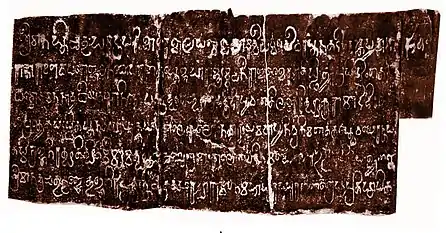Rama Rajasekhara
Rama Rajasekhara (fl. 870/71–c. 883/84 AD[2]) was a Chera Perumal ruler of medieval Kerala, south India.[3][4][5] Rajasekhara is usually identified by historians with Cheraman Perumal Nayanar, the venerated Shaiva (Nayanar) poet-musician.[5][3][1] Two temple records, from Kurumattur, Areacode and Thiruvatruvay, Vazhappally, mention king Rajasekhara.[6]
| Rajasekhara | |||||||||
|---|---|---|---|---|---|---|---|---|---|
| Sri Raja Rajadhiraja Parameswara Bhattaraka "Rajashekhara" Deva Peruman Adigal | |||||||||
_(cropped).jpg.webp) Depiction of "Cherman Perumal" Nayanar in Brihadisvara Temple, Thanjavur | |||||||||
| Ruler of Kodungallur Chera (Perumal) Kingdom[1] | |||||||||
| Reign | 870/71–c. 883/84 AD | ||||||||
| Predecessor | Sthanu Ravi Kulasekhara | ||||||||
| Successor | Vijayaraga | ||||||||
| |||||||||
| House | Chera Perumals of Makotai | ||||||||
| Religion | Hinduism (Shaiva) | ||||||||
| Grantha | |||||||||
Rajasekhara probably succeeded Sthanu Ravi Kulasekhara around 870 AD.[2][7] It is also suggested that Cheraman Perumal Nayanar was on friendly terms with the Pallava dynasty.[8]
The direct authority of the Chera Perumal king was restricted to the country around capital Makotai (Mahodaya, present-day Kodungallur) in central Kerala.[9] His kingship was only ritual and remained nominal compared with the power that local chieftains (the udaiyavar) exercised politically and militarily. Nambudiri-Brahmins also possessed huge authority in religious and social subjects (the so-called ritual sovereignty combined with Brahmin oligarchy).[9][10]
Rama Rajasehara probably abdicated the throne toward the end of his reign and became a Shaiva nayanar known as Cheraman Perumal Nayanar.[6] He was succeeded by Vijayaraga (fl. c. 883/84-c.895 AD).[2]
Sources
- Shivanandalahari, attributed to Hindu philosopher Shankara, indirectly mentions the Chera ruler as Rajasekhara.[11]
- Rajasekhara is also tentatively identified with king "Co-qua-rangon" mentioned in the Thomas of Cana copper plates.[12]
Rama Deva
Laghu Bhaskariya Vyakhya, a mathematical commentary composed in the court of king Ravi Kulasekhara in 869/70 AD, mentions a Chera Perumal royal called Rama Deva, who marched out to fight the enemies on getting information from the spies.[13] A possibility identifies Rama Deva with Rama Rajasekhara.[14] Rama Deva is described as a member of the Solar Dynasty ("ravi-kula-pati") in Chapter IIII, Laghu Bhaskariya Vyakhya.[13]
Patron of Vasubhatta
Vasubhatta, a famous Yamaka poet of medieval Kerala, names his patron king as "Rama". A later commentary on a poem by Vasubhatta says that "Kulasekhara" was the regnal title of king Rama.[15] Scholars generally consider this a result of confusion on the part of the commentators (between Sthanu Ravi Kulasekhara and Rama Rajasekhara) who were seprated in time from Vasubhatta.[15] Some scholars also identify king Rama Kulasekhara as the patron of poet Vasubhatta (and thus placing Vasubhatta in 11th-12 centuries AD).[16] This view is generally found unacceptable on several counts.[17]
Epigraphic records
| Date | Regnal Year | Language and Script | Location | Contents | |||
|---|---|---|---|---|---|---|---|
| Nature | Notes | ||||||
| 871 AD[6] | N/A | Grantha/Southern Pallava Grantha (Sanskrit)[18] | Kurumattur Vishnu temple, Areacode. - engraved on a loose, granite slab.[18][6] | Temple inscription[19] |
| ||
| c. 882/83 AD[6] | 13[22] | Vattezhuthu with Grantha/Southern Pallava Grantha characters (old Malayalam)[22] |
|
Temple committee resolution[22] |
| ||
References
- Narayanan, M. G. S. Perumāḷs of Kerala. Thrissur (Kerala): CosmoBooks, 2013. 64-65.
- 'Changes in Land Relations during the Decline of the Cera State,' In Kesavan Veluthat and Donald R. Davis Jr. (eds), Irreverent History:- Essays for M.G.S. Narayanan, Primus Books, New Delhi, 2014. 74-75.
- Noburu Karashmia (ed.), A Concise History of South India: Issues and Interpretations. New Delhi: Oxford University Press, 2014. 143.
- Narayanan, M. G. S. Perumāḷs of Kerala. Thrissur (Kerala): CosmoBooks, 2013. 64-66, 88-95, 107.
- Veluthat, Kesavan. “The Temple and the State in Medieval South India.” Studies in People’s History, vol. 4, no. 1, June 2017, pp. 15–23.
- 'Changes in Land Relations during the Decline of the Cera State,' In Kesavan Veluthat and Donald R. Davis Jr. (eds), Irreverent History:- Essays for M.G.S. Narayanan, Primus Books, New Delhi, 2014. 58 and 74-75.
- Veluthat, Kesavan. 2004. 'Mahodayapuram-Kodungallur', in South-Indian Horizons, eds Jean-Luc Chevillard, Eva Wilden, and A. Murugaiyan, pp. 471–85. École Française D'Extrême-Orient.
- Narayanan, M. G. S. Perumāḷs of Kerala. Thrissur (Kerala): CosmoBooks, 2013. 80-93.
- Noburu Karashmia (ed.), A Concise History of South India: Issues and Interpretations. New Delhi: Oxford University Press, 2014. 143-44.
- Narayanan, M. G. S. 2002. ‘The State in the Era of the Ceraman Perumals of Kerala’, in State and Society in Premodern South India, eds R. Champakalakshmi, Kesavan Veluthat, and T. R. Venugopalan, pp.111–19. Thrissur, CosmoBooks.
- Narayanan, M. G. S. Perumāḷs of Kerala. Thrissur (Kerala): CosmoBooks, 2013. 64 and 77.
- Narayanan, M. G. S. Perumals of Kerala: Brahmin Oligarchy and Ritual Monarchy—Political and Social Conditions of Kerala Under the Cera Perumals of Makotai (c. AD 800–AD 1124) Thrissur (Kerala): CosmoBooks, 2013. 302-303.
- Narayanan, M. G. S. Perumāḷs of Kerala. Thrissur (Kerala): CosmoBooks, 2013. 64-66 and 78-79.
- Narayanan, M. G. S. Perumāḷs of Kerala. Thrissur (Kerala): CosmoBooks, 2013. 79-80.
- Veluthat, Kesavan (1982). "The Status of the Monarch". Proceedings of the Indian History Congress. 43: 147–157. ISSN 2249-1937.
- Vielle, Christophe (2012). "Real and Ideal Kings in Matrilineal Kerala". Religions of South Asia. 5 (1): 365–387. doi:10.1558/rosa.v5i1/2.365.
- Devadevan, Manu V. (2020). "The Semantic Universe of the Kudiyattam Theatre". The 'Early Medieval' Origins of India. Cambridge University Press. pp. 229–30.
- Veluthat, Kesavan (1 June 2018). "History and historiography in constituting a region: The case of Kerala". Studies in People's History. 5 (1): 13–31.
- Indian Archaeology 2010-2011 – A Review (2016) (p. 118)
- Indian Archaeology 2010-2011 – A Review (2016) (p. 118)
- Naha, Abdul Latheef. Ancient inscription throws new light on Chera history. February 11, 2011 The Hindu
- Narayanan, M. G. S. Perumāḷs of Kerala. Thrissur (Kerala): CosmoBooks, 2013. 435.
- Rao, T. A. Gopinatha. Travancore Archaeological Series (Volume II, Part II). 8-14.
External links
- Mathew, Alex - Political identities in History (2006) Unpublished Doctoral Thesis (M. G. University)
.jpg.webp)
